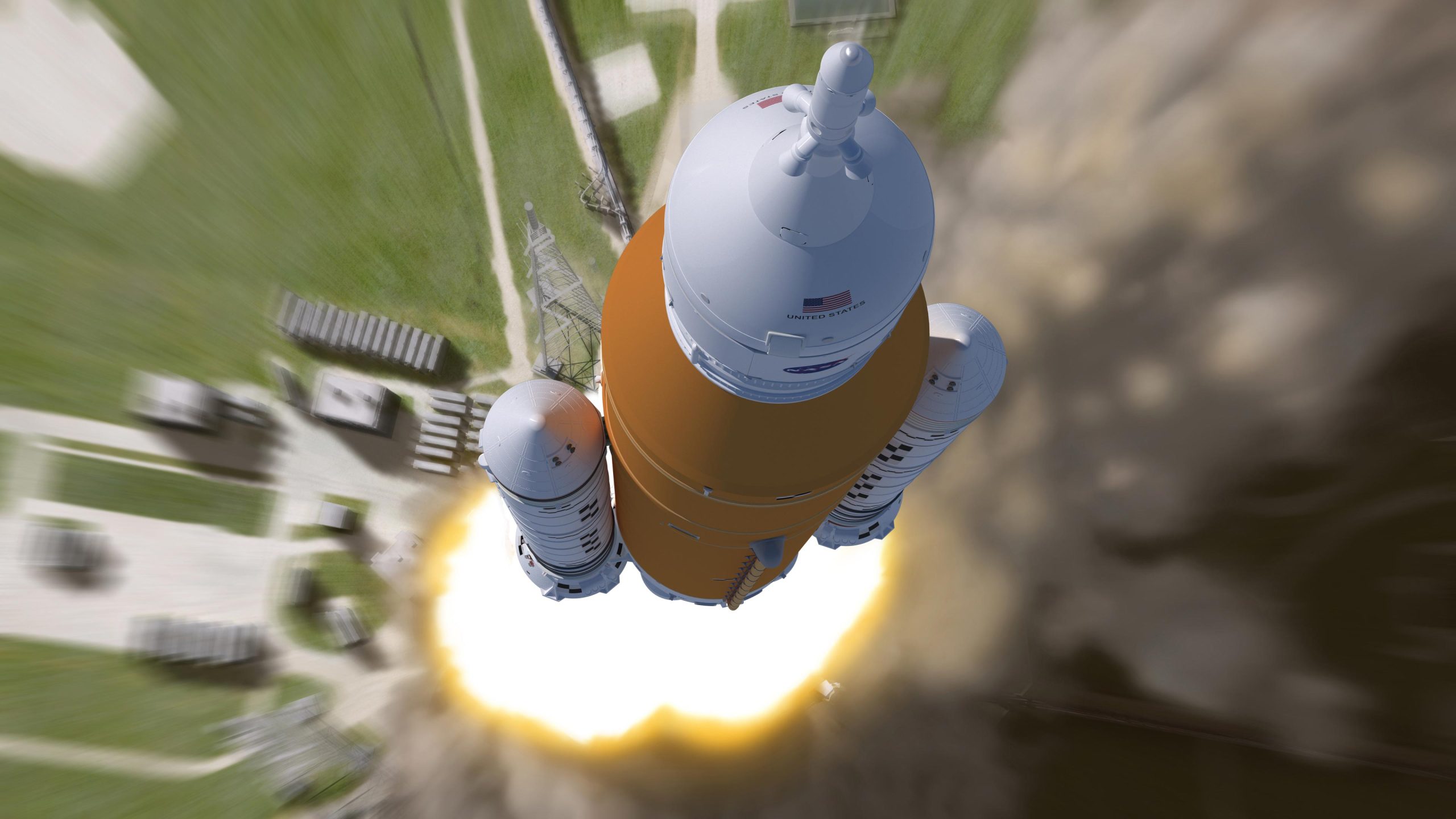
이 예술가의 렌더링은 NASA 우주 발사 시스템(SLS) 로켓 발사의 조감도를 보여줍니다. 블록 1의 이 로켓 승무원 구성은 세 개의 아르테미스 임무 중 첫 번째 임무를 달로 보낼 것입니다. 크레딧: NASA/MSFC
launch countdown will begin at 1:24 a.m. on Monday, November 14.
Artemis I is the first integrated flight test of NASA’s Space Launch System (SLS) rocket, an uncrewed Orion spacecraft, and the ground systems at the agency’s Kennedy Space Center in Florida. SLS is a super heavy-lift launch vehicle with unprecedented power and capabilities that provides the foundation for human exploration beyond Earth’s orbit. Orion is NASA’s new human spacecraft for deep-space missions that will serve as the exploration vehicle that will carry the crew to space, provide emergency abort capability, sustain astronauts during their missions and provide safe re-entry from deep space return velocities. The Artemis I mission will pave the way for a crewed test flight and future human lunar exploration as part of Artemis.
Following Hurricane Nicole, teams conducted thorough assessments of the rocket, spacecraft, and associated ground systems and confirmed that there were no significant impacts from the severe weather. The SLS rocket and Orion spacecraft arrived at Kennedy’s Launch Pad 39B on November 4 and rode out the storm there.
Live coverage of briefings and events will air on NASA Television, the NASA app, and the agency’s website at: https://www.nasa.gov/live

NASA’s Space Launch System (SLS) rocket with the Orion spacecraft aboard is seen atop the mobile launcher at Launch Pad 39B, Friday, November 11, 2022, at NASA’s Kennedy Space Center in Florida. Teams began walkdowns and inspections at the pad to assess the status of the rocket and spacecraft after the passage of Hurricane Nicole. NASA’s Artemis I flight test is the first integrated test of the agency’s deep space exploration systems: the Orion spacecraft, SLS rocket, and supporting ground systems. Launch of the uncrewed flight test is targeted for no earlier than November 16 at 1:04 a.m. EST. Credit: NASA/Joel Kowsky
Engineers previously rolled the rocket back to the Vehicle Assembly Building (VAB) on September 26 ahead of Hurricane Ian and after waving off two previous launch attempts on August 29 due to a faulty temperature sensor, and September 4 due to a liquid hydrogen leak at an interface between the rocket and mobile launcher. Before to rolling back to the VAB, teams successfully repaired the leak and demonstrated updated tanking procedures. While in the VAB, teams performed standard maintenance to repair minor damage to the foam and cork on the thermal protection system and recharge or replace batteries throughout the system.

NASA’s Space Launch System (SLS) rocket with the Orion spacecraft aboard is seen atop the mobile launcher at Launch Pad 39B, Friday, November 11, 2022, at NASA’s Kennedy Space Center in Florida. Teams began walkdowns and inspections at the pad to assess the status of the rocket and spacecraft after the passage of Hurricane Nicole. NASA’s Artemis I flight test is the first integrated test of the agency’s deep space exploration systems: the Orion spacecraft, SLS rocket, and supporting ground systems. Launch of the uncrewed flight test is targeted for no earlier than November 16 at 1:04 a.m. EST. Credit: NASA/Joel Kowsky
Full launch coverage is as follows. All times are Eastern, and the information is subject to change.
Sunday, November 13
7 p.m.: NASA will hold a prelaunch media teleconference following a mission management team meeting with the following participants:
- Bill Nelson, NASA administrator
- Mike Sarafin, Artemis mission manager, NASA Headquarters
- Charlie Blackwell-Thompson, Artemis launch director, Exploration Ground Systems Program, Kennedy
- Emily Nelson, chief flight director, NASA Johnson
- Melody Lovin, weather officer, U.S. Space Launch Delta 45
Monday, November 14
12 p.m.: NASA will hold a prelaunch media briefing on NASA TV to provide a status on the launch countdown with the following participants:
-
Jeremy Parsons, Exploration Ground Systems Program deputy manager, NASA Kennedy
-
Melody Lovin, weather officer, U.S. Space Launch Delta 45
Tuesday, November 15
3:30 p.m.: NASA TV commentary coverage of tanking operations to load propellant into the SLS rocket begins, including views of the rocket and Launch Control Center, and audio from a commentator.
10:30 p.m.: NASA TV commentary coverage of launch begins in English. Coverage will continue through translunar injection and spacecraft separation, setting Orion on its path to the Moon.
Wednesday, November 16
12 a.m.: NASA TV commentary coverage of launch begins in Spanish on NASA’s Spanish-language YouTube account and will continue approximately 15 minutes after liftoff. Mission coverage updates will be posted on the NASA en español social media channels.
4 a.m.: NASA TV coverage of the postlaunch news conference will follow approximately one hour after the live launch broadcast ends. Coverage start time is subject to change, based on the exact liftoff time. The postlaunch news conference will include the following participants:
- Bill Nelson, NASA administrator
- Mike Sarafin, Artemis mission manager, NASA Headquarters
- Mike Bolger, Exploration Ground Systems Program manager, Kennedy
- John Honeycutt, Space Launch System Program manager, Marshall
- Howard Hu, Orion Program manager, NASA’s Johnson Space Center
- Emily Nelson, chief flight director, Johnson
8:30 a.m.: NASA TV commentary coverage of Orion’s first outbound trajectory burn on the way to the Moon. Coverage start time is subject to change, based on the exact liftoff time.
10 a.m.: NASA TV commentary coverage of first Earth views from Orion during outbound coast to the Moon.
NASA Television coverage of additional events throughout the mission is available online.

NASA’s Space Launch System (SLS) rocket with the Orion spacecraft aboard is illuminated by spotlights atop the mobile launcher at Launch Pad 39B as preparations for launch continued Sunday, November 6, 2022, at NASA’s Kennedy Space Center in Florida. SLS and Orion arrived at the launch pad on Friday, November 4, after a nearly nine-hour journey from the Vehicle Assembly Building. Credit: NASA/Joel Kowsky
Attend Launch Virtually
Members of the public can register to attend the launch virtually. NASA’s virtual guest program for the mission includes curated launch resources, notifications about related opportunities or changes, and a stamp for the NASA virtual guest passport following a successful launch.
Watch, Engage on Social Media
Stay connected with the mission and let people know you are following the launch on Twitter, Facebook, and Instagram with #Artemis. Follow and tag these accounts:
The public can track the Artemis I mission as it happens using to Artemis Real-time Orbit Website, which will provide information about where Orion is in relation to the Earth and the Moon. Individuals also can also download a virtual boarding pass to commemorate the historic flight.
Through Artemis missions, NASA will land the first woman and the first person of color on the lunar surface and establish long-term exploration at the Moon in preparation for human missions to Mars. SLS and NASA’s Orion spacecraft, along with the commercial human landing system and the Gateway in orbit around the Moon, are NASA’s backbone for deep space exploration. SLS is the only rocket that can send Orion, astronauts, and supplies to the Moon in a single mission.

“음악 팬. 매우 겸손한 탐험가. 분석가. 여행 괴짜. 익스트림 TV 전문가. 게이머.”










